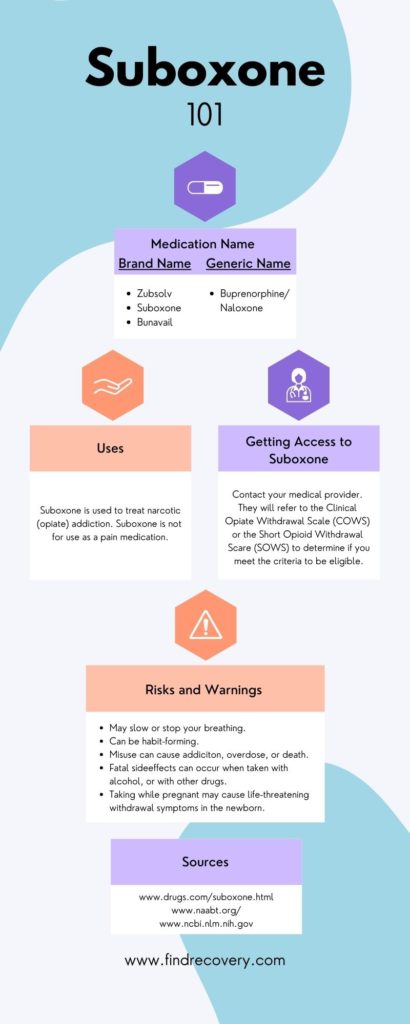Suboxone, the brand name of a widely used medication for treating opioid addiction, has numerous and significant benefits for those in recovery. It can increase treatment retention rates, decrease rates of overdose and relapse, lower mortality rates, and reduce the need for inpatient detox treatment. However, as is the case with many types of medications, it can take some time before the positive effects take place–time that the nature of addiction may not allow.
So how long does suboxone take to work?
In this article, we’ll cover all timely matters related to this popular MAT medication including how long the effects last and how long to wait to take suboxone.
What is suboxone used for?

Not all MAT medications are the same or used for the same purpose. Suboxone is a combination of buprenorphine and naloxone used during the early stage of recovery (detox) as well as the maintenance stages. In addition to being valuable for reducing the likelihood and severity of any experienced withdrawal effects, suboxone can also be used for long-term use to reduce cravings and lower the risk of relapse.
Suboxone dosage is very likely to vary depending on the stage of a person’s addiction recovery. The strongest doses are used at the beginning of treatment, a stage referred to as ‘induction’. In this stage, suboxone is used to prevent and alleviate opioid withdrawal symptoms as soon as possible. In addition to being potentially dangerous, the discomfort experienced during withdrawal is one of the most common reasons why patients abandon treatment or avoid seeking it altogether.
How long does it take for suboxone to kick in?
The amount of time it takes for suboxone to start working can vary depending on 1) the dosage and 2) the method of administration (more on that later). Generally, Suboxone reaches its peak within 30 minutes but its effects can last up to 24 hours.
The sublingual form of suboxone (a thin dissolvable film that’s placed under the tongue) is the most effective and fast-acting. Suboxone is also available in a pill form, however, any medication ingested via the digestive tract will take more time to enter the bloodstream and therefore will be slower acting. Neither form of suboxone should ever be chewed or swallowed whole.
Suboxone’s Half-Life
Even if you no longer feel Suboxone’s effects, it’s important to be mindful that Suboxone also has a considerable half-life of 5 to 8 days–and could be up to 60 hours longer for those with impaired liver function. Why does this matter? Suboxone is a central nervous system depressant and mixing it with other depressants like benzos, can cause life-threatening effects.
How long to wait to take suboxone?
Suboxone offers relief and hope to those struggling with opioid addiction but its effectiveness is affected by the timing of use. First off, suboxone will only work for individuals who have opioid dependence. It will not benefit those who are irregular opioid abusers nor will it have any effect as a precautionary measure to protect against addiction.
Patients must be experiencing at least mild withdrawal in order to experience any of suboxone’s benefits. Determining when you can take suboxone will largely depend on the type of opioids that were used. Short-acting opioids such as heroin, codeine, or fentanyl will have an onset of withdrawal symptoms 8-24 hours after they were last used. Long-acting opioids such as methadone can take between 24 to 48 hours for the onset of withdrawal.
Will I qualify for suboxone?
Medical professionals refer to either the Clinical Opiate Withdrawal Scale (COWS) or the Short Opioid Withdrawal Scare (SOWS) to confirm patients meet the criteria to be eligible for suboxone. These scales rank the severity of various symptoms and tallied to create a score that determines whether an individual is in mild, moderate, or severe withdrawal. The types of MAT medications and their dosage will be prescribed depending on the severity of your withdrawal.
Is suboxone safe?
A common misconception surrounding suboxone, and medication-assisted treatment in general, is that it’s trading one addiction for another. Even though Suboxone is a very weak form of an opioid that doesn’t provide a high, it does have the potential for abuse–any medication does. Suboxone has minimal risks when taken as directed. Overall, the potential benefits of suboxone far outweigh the potential risks for many people addicted to opioids. If you’re on the fence about taking part in medication-assisted treatment, you’d likely benefit from hearing from others recovering from opioid addiction and their experiences with this medication. Find a Narcotics Anonymous meeting near you, today.
